Dec 21st, 1964 and Dec 23rd, 1964. The high point of Bondage
Ed Note: One of the Philadelphia based Israeli dancers, who requests anonymity, fancies himself as a bit of a historian (the emphasis should be on bit). This piece is a companion to another script on this web site entitled Two Men and an Island. We did ask him to add something relative in this script to the purposes of this web site and there is a half-hearted, somewhat negative try at the end. Not quite what we had in mind, but it will have to do.
 Let's start this script by asking you hypothetically what movie you would see next Dec 21st (or perhaps last Dec 21st). Possibly something starring Daniel Craig who seems to appear in many movies (or when this was written in 2011 specifically 'the Girl with the Dragon Tattoo' which starred Daniel Craig at the time). You may recall that Craig has been a star in another series of movies which might give you a hint if we were to ask a similar question: What movie would you go see on Dec 21st, 1964?
Let's start this script by asking you hypothetically what movie you would see next Dec 21st (or perhaps last Dec 21st). Possibly something starring Daniel Craig who seems to appear in many movies (or when this was written in 2011 specifically 'the Girl with the Dragon Tattoo' which starred Daniel Craig at the time). You may recall that Craig has been a star in another series of movies which might give you a hint if we were to ask a similar question: What movie would you go see on Dec 21st, 1964?
Dec 21, 1964 would have been on a Monday (as indicated in the calendar to the right) with the big event of that week on Friday: Christmas,1964. For the 20th century, those years before 1950 would have seen the winter solstice (the shortest day of the year) occur on Dec 22. After 1950, the preponderance of winter solstice days would be Dec 21st and 1964 was no exception. That year was also a leap year and its tradition in many countries that women may propose marriage on leap years so its possible that Dec 21st, 1964 would have seen a good number of men being asked their hand in marriage.
Christmas week, at that time, would have been a good week for movies (and movie debuts) as students would be home from College and others would be shopping and possibly off from work. This is always a good time of the year to get together with friends and in 1964, what better way to catch up on each other's lives seeing a movie together. Today, computer and social networks might give you more alternatives, but '64 was before cable and internet capabilities.
Before we answer what we would have gone to see (and in fact did go to see although we waited until early January 1965 to do it) let's discuss the world as it was in 1964. As this is written 47 years have elapsed and any 47 year gap will have seen technological, political and sociological changes. It's inevitable! And keep in mind that 1964 is closer to the end of World War II than it is to our present period. Political events were still shaped by that war and its cataclysmic events.
Note that two years previous was the Cuban missile crises where both sides threatened each other with modified (and advanced) German weapons, be they missiles or jets. The other side (against us) in this case was the USSR which does not exist at this moment having been re-formed as Russia and the Commonwealth of Independent States (the former SSRS) in 1991 from which they came although as of yet no Czar has re-emerged. Cuba, with North Korea, are perhaps the only countries still pretending to be part of the Soviet bloc of that era although such a bloc really doesn't exist.
Another member of the Soviet bloc at that time was the People's Republic of China. Despite what Herman Cain believes, two months previous to our specific date of Dec 21, 1964, China exploded its first nuclear bomb. Interestingly enough, the use of a Chinese nuclear device weighs heavily in our question of what movie we would have seen that Dec 21st (in 1964)
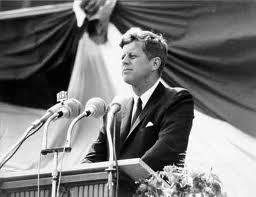
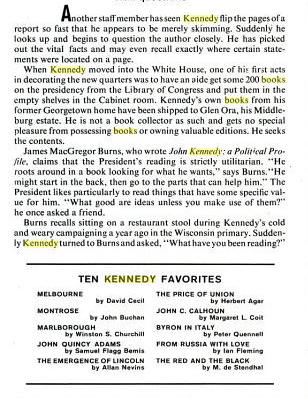
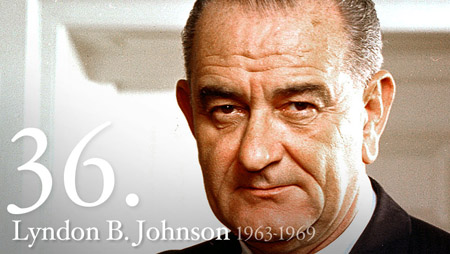
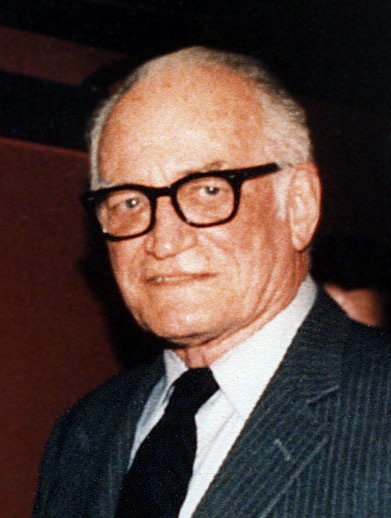
In this country, the populace to some degree was still recovering from the assassination of President Kennedy the year before. Kennedy and his wife were not just political leaders but leaders in terms of fashion, style and appearance. They influenced fashion and mores and to some degree what people were reading (and reading was the main conduit of information at that time). Shortly after Kennedy was inaugurated, Life magazine had published Kennedy's top 10 favorite books and this spurred sales of these mentioned books and their authors. It will never be known how the only fictional book, and by a British author, no less, was placed on that list, but just the mention of the book spurred this author's sales in this country and created an interest in what could only be considered a very unique personality and life not to mention his books centering on a specific hero. And, to be fair, this author exaggerated many details to make himself seem even more interesting.
As far as internal US politics, the month before in early November would see a landslide victory of the then president, Lyndon Johnson, over Senator Barry Goldwater. Johnson had been the Vice President at the time of the Kennedy assassination and replaced the slain president. He had run on a campaign of peace although he was planning something very different once the election of 1964 was over. Although most citizens were not aware, this country was about to plunge into a war on the asian continent is direct contradiction to what had been campaigned, but this was to be in the future and is beyond the scope of this script.
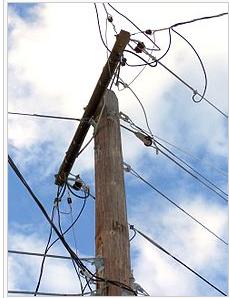
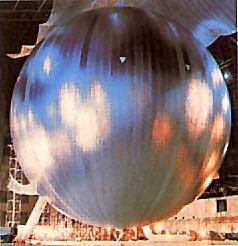
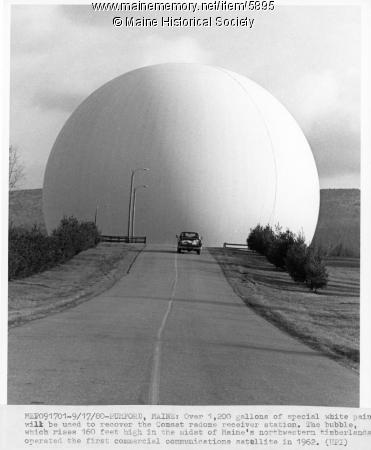
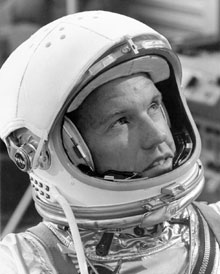
How about technology and how it was used? Much of communications was still land based. The internet would be created a few years in the future and not be a commercial application for several decades. As far as television, this was done on the airwaves as there was no cable and at the time there were 3 national networks, NBC, CBS and ABC, Interestingly enough, ABC was a byproduct of NBC which was so strong in the late 1940's (while radio was still king) that it was composed of two distinct and competing radio networks (NBC blue and red) and it is assumed that pressure was applied to NBC to divest itself of one of its networks and so we have ABC. These radio networks, with the exception of the Mutual broadcasting network, moved into television and color TV had only become available some 5 years before our date (Dec 21, 1964) in question per this script. NBC still introduced color programs with a peacock and the slogan, "presented in lving color".
If you had studied media in this time period, it would have been clear that this country at that point was not going 24/7 (as they say today) anytime soon. About a year and a half prior, in mid 1963, the first 24 hour American space shot had occurred and the television networks, for the first time, stayed active through the entire night. This was a one day affair and by the next day the networks had returned to normal. While radio had limited 24 hours service, even that was sporadic with clear channel stations (large powerful stations whose broadcasting frequency was not duplicated anywhere else in the US) expected to provide considerable programming throughout the evening but even these clear channel stations self limited their programming selections.
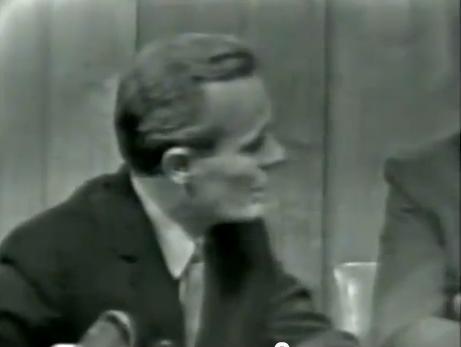
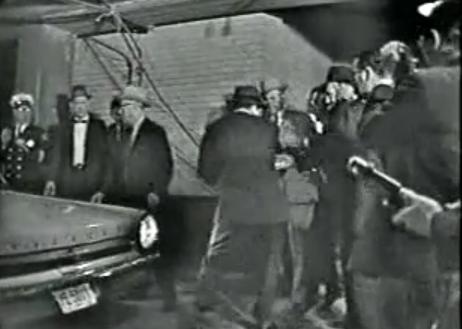
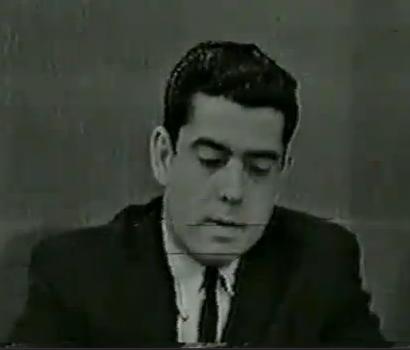
The events of Nov 22nd, 1963, and through that weekend, would create a second need for 24 hour programming when President Kennedy was assassinated. Even here, one could see the limitations of programming at that time. NBC, for instance, needed at least 6 hours to establish a link to its affiliate in Dallas and begin broadcasting live from that city. This was probably the first time that network TV broadcast live from a site outside of studios in New York, Washington, Chicago or LA. Changes would have come no matter what would have happened. On August 12th, 1960, the satellite Echo was launched and became a reflector of signals from earth - the first use of satellite communication. By 1962, Telstar was launched and limited communication between this country and Europe through satellite became possible. In fact, just to add to the trivia of this script, the Philadelphia Phillies were featured playing the Chicago Cubs at Chicago's Wrigley field on July 23, 1962 in a special broadcast originating that day from Europe and the United States. Here in the States, Europeans (and any Americans watching) were treated to a panarama of late summer events including this baseball game. While most will report that Tony Taylor was at bat for this event, recollection by the author indicates that it was Johnny Callison (or at least Callison got the first hit) on international TV. Whatever, you can see that media was not 24/7 or international as it is today. But what media was being aired?
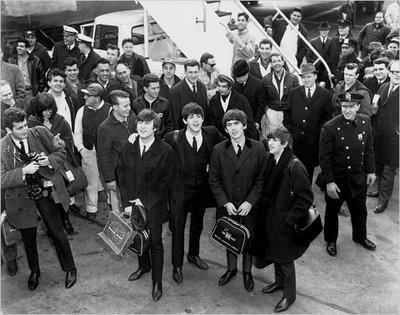
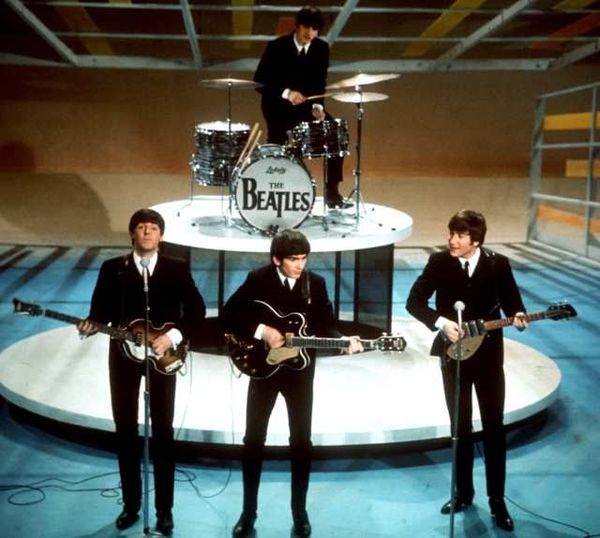
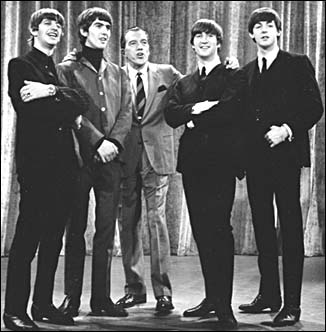
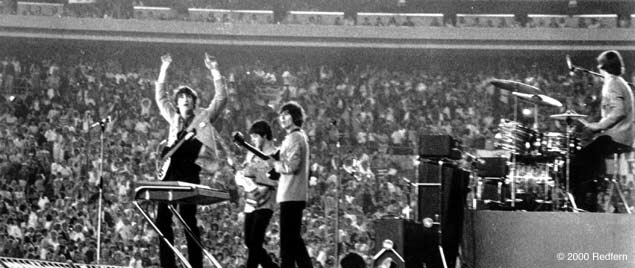
While this script will eventually focus on one British invasion, a second had occurred during 1964. A band from Liverpool, who had spent considerable time in West Germany playing 18 hour gigs for long durations (and to see how this was a factor, a section of the 'Outliers' by Malcolm Gladwell deals with this), had become extremely popular as they returned to England. Adorned with the latest mod fashion, the foursome, all in their early 20's, had become all the rage of every teen aged girl on that island. Their fame and adoration was to be spread to this country when they landed in New York in early February, 1964. Three successive weeks on the Ed Sullivan show on Sunday nights, was enough to make every teenaged girl in this country go crazy not to mention probably go sleepless on the Saturday night before. This was called a British invasion per the music and the style, but another one had been brewing for a year or two before this and would come to fruition on Dec 21st, 1964 in New York and in early January around the rest of the country.
We've given you some clues here. Of course, you could and possibly will try to circumvent the rest of this discussion and look at Dec 21, 1964 on google or other search engines. You probably won't easily find what the rest of this discussion is about. You will most definitely find another big event, at least as far as media entertainment would be concerned, with the release of the song, "my girl", by the Temptations on that day. You will also find indication that a famous personality, Fabiana Udenio, was born on that day but this writer has no idea who she is and, if you do, contact this web site with that information by clicking here and we'll add it to this script. The event we are talking about really is not indicated (unless google picks up this script for display) and yet it was the culmination of several trends dealing with movies, entertainment and media including the first recorded 24 hour cinema cycle. So, back to our question, what movie would you stand in line to see on that day if you had the opportunity? We know our pick but we do want to give you some options of movies that were playing at that time, some of which are relatively famous both for the movie and actors who were in them.
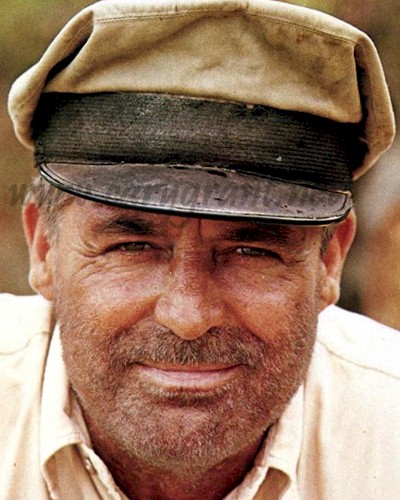
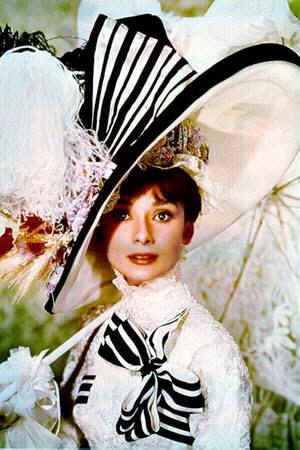
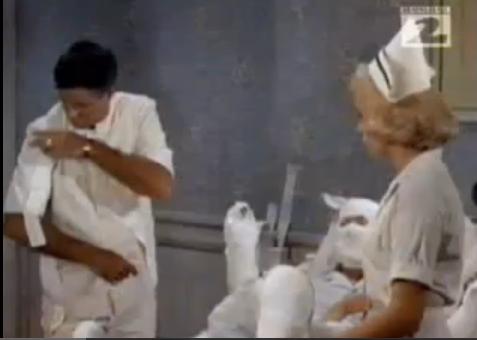
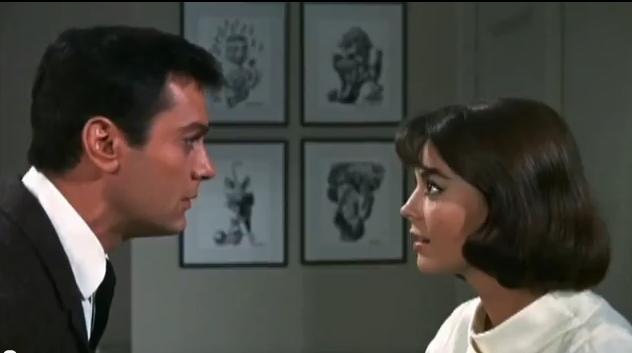
You could have gone and seen Cary Grant in his next to last movie, Father Goose. This was his last leading role and in a year he would play second fiddle in the unmemorable, 'Walk, don't run'. It is said that his ego would not allow him to play supporting roles and 'Walk, Don't Run' was his last movie that he appeared in. He would spend the rest of his life acting as a corporate spokesman for various companies.
Fans of Helen Gurley Brown, then the editor of Cosmopolitan magazine and the author of 'sex and the single girl' could watch an attempt to film her book starring Natalie Wood and Tony Curtis. We assume Ms Wood played the single girl and Curtis supplied the sex. The other British invasion had an entry in the movies at that point as the Beatles starred in A Hard day's Night which was still in theaters at that time although it had been released in July of that year. This shows how movies were attended in that day as it was not unusual to see a movie released months earlier. Today, most theaters are part of megaplexes and the megaplex has interest in only the most recent of releases.
Continuing, a favorite of theater goers - it had run over 6.5 years on the New York stage - had been turned into a movie, My Fair Lady, with its own controversy as Audrey Hepburn replaced Julie Andrews on screen with the help of a singing double. Shortly, Andrews would get some type of revenge when starring as Mary Poppins. Finally, you could have decided to see the latest Jerry Lewis movie, the disorderly orderly. Long before running the muscular distrophy marathon, Lewis was first a cabarat star with his partner, Dean Martin, and then became a movie star. The partnering of Lewis and Martin, from 1946 through 1956, is also very interesting to study as it shows the same effects and characteristics of the Media blitz and fads exhibited by the Beatles in their first visit to New York and what we will eventually be discussing in this script although ours involved both sexes while Martin and Lewis and the Beatles was female oriented. Anyway, at this time, Dec 21, 1964, perhaps, like the French, you would have considered Lewis a comic genius and flocked to his movies.
Yet, from what we know about attendance and profitability, we think (and we know in our case) another movie would have been a requirement to see that Christmas season. Let's give some hints for you to guess.
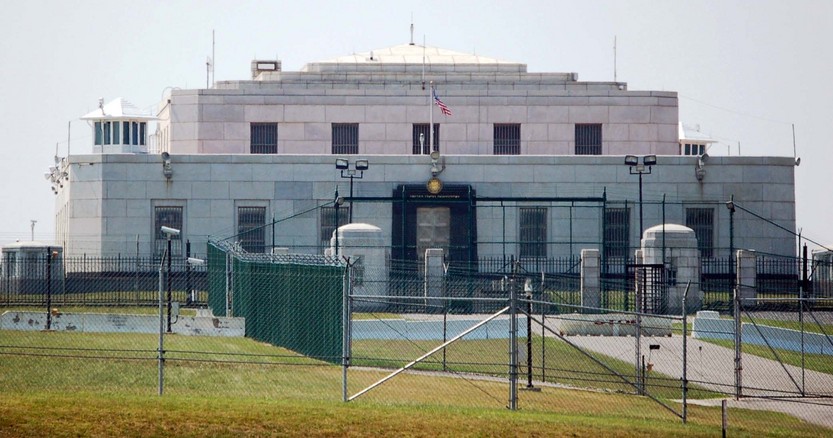
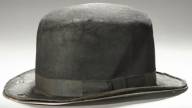
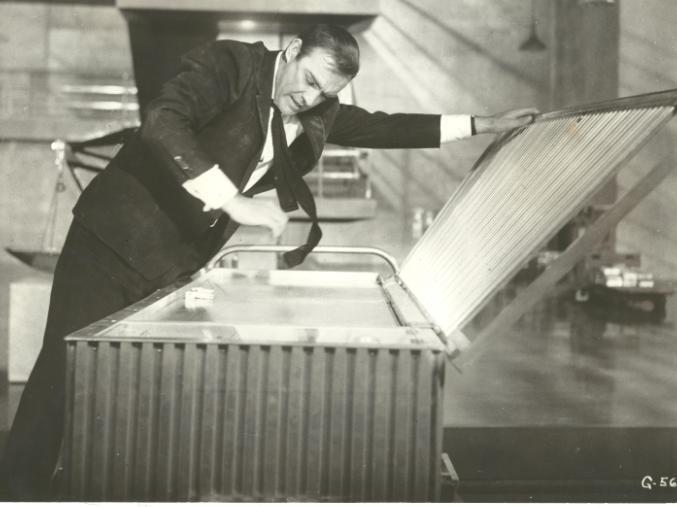
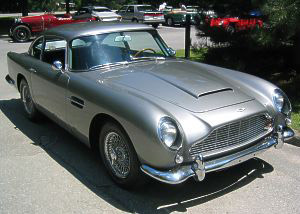
This movie's basis was the hero of a series of books published in England through the 50's and 60's. They were the work of an extremely creative writer who wrote these on the side of his day job in journalism. The writer's unique life style in itself fueled the popularity of these books and this had only increased given his death on August 12, 1964. Even the manner of the death, apologizing for bothering and disrupting the day for the emergency crew sent to take him to the hospital only fueled interest in his writings. In the past two years, 1962 and 1963, two previous movies had been made dealing with these books. At this time, if you were a fan of the books, you wanted to see how scriptwriters would interpret the world of this hero and the movie in question pertained to the seventh book of the series following the sixth and fifth respectively. In addition, given that the books were absolutely void of humor, the films gave a different perspective to this hero given that the screen writers worked overtime to provide humor in strenuous situations. The books already had a set of memorable lines including, 'shaken not stirred' pertaining to specific martinis, 'a bee in one's bonnet' when dealing with tedious issues and we'll let you guess in what situations one would read 'her breasts pointed with desire'. If you had become a fan of this nascent series of movies, you wanted to see how much more advanced the editing techniques had been pushed, Extreme usage of wipes sped the dialogue and action and this use of such created, in essence, a whole new genre of movie production. This is not to say that the movies didn't have their own specific lines, some relatively funny as when the hero said 'she's had her kicks' or 'they were on their way to a funeral' but especially when the hero introduced himself. Finally, If you were a fan of both, with the recent death of the author, you were interested to see where the movie producers would push the character, our hero, as they now wore the responsibility of his future development.
If you still are not sure which movie we are discussing, let's give you a few more hints. The book and movie adaptation centered on the most audatious heist ever fictionalized, the robbery of the gold in Ft Knox. Today, there is a question of how much gold there really is stored in those vaults but at the time of the release of the movie, there was no question that gold, galore, was there. For those old enough at the time, this would bring back memories of the original movement of this bullion into Kentucky. Worried about German air strikes against east cost cities, the Federal government had engineered this movement to the well protected environs of this fort from the New York Federal Reserve vaults in 1937.
In the book, our hero has the use of an automobile with some added enhancements. This auto can change lights, rotate license plates, hide guns and ammo and, most importantly, home in to some degree to a planted radio signal. In the movie, this becomes a car on steriods with front machine guns, rear tacks and oil discharge, a type of GPS far in the future of that technology and a passenger ejection seat. In the months before the movie release, this car would be on tour throughout the United States providing more publicity for the coming film and in most cases it would be driven by a German refugee of Nazi persecution whose set designs and ideas for props such as this car would become legendary.
Although the production of this film would be before the event, the film presaged the first nuclear tests of the Chinese government as the film portrayed the villian having access to such a nuclear device. The book, written some 6 years before, had the villian within the Soviet orbit of influence.
The villian's chief henchman was a martial art expert both in the book and movie. In the movie, however, this fed into such interests as was increasing in the United States. In both aspects of media, the henchman wore a steel bordered bowler hat which he used as a lethal weapon.
The book dealt with, and the movie moved tangentially, into lesbianism and the name of the eventual heroine would be laced with great controversy. Interestingly enough, those who were friends and acquaintances of the author knew that the villian's name also was a controversial issue. Another facet of how women were treated during this time period would be starkly evident in the visual death of one of the bit players in the movie which was alluded to in the book: The body painting of a woman left to die from a type of suffocation.
A name of a character, killed in a supposed fall in the book and squashed in a Lincoln Continental in the movie, would be linked to a very popular American TV program within a short duration.
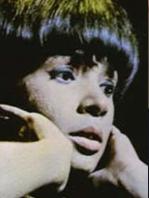
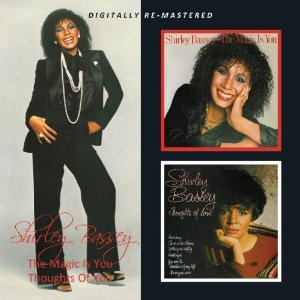
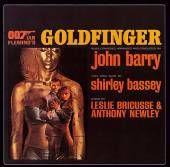
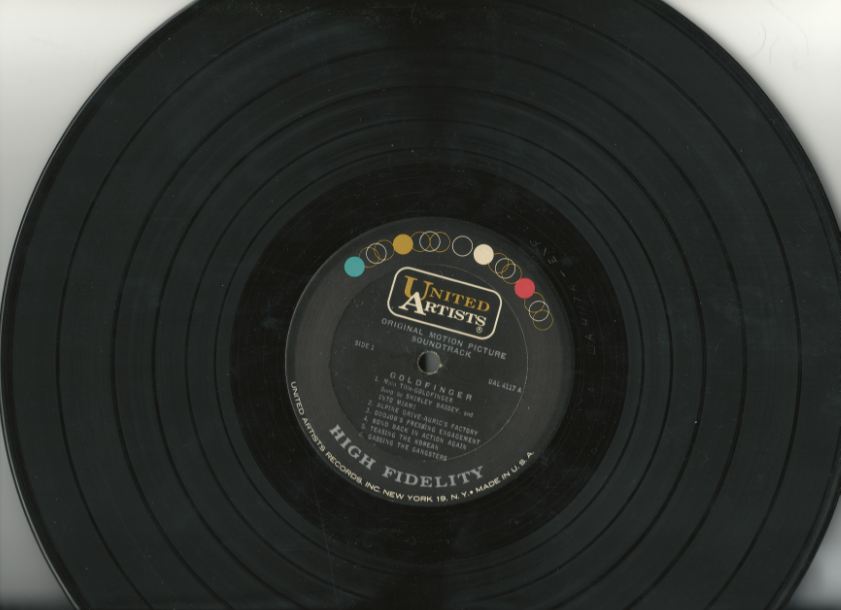
And, finally, this movie allowed most American to become familiar with one of most popular cabaret singers in England at that time. The theme song would become her signature and no one has ever outdone her singing of this song. The album and title song was introduced a few months prior to the opening of the movie and many wondered how any mortal could hold the notes that she did at the end of the song.
No doubt, by this point, our direction is clear. Did we give you enough hints? As the hero says in this movie, "but, of course", and by this time you know the name and the hero. Dec 21st, 1964, would see the debut of the third James Bond movie, Goldfinger, in the United States. Goldfinger, to one way of thought, was part of another British invasion into this country competing to some degree with the Beatles who interestingly enough are mentioned, in a somewhat scornful way, within the early scenes of this movie. You may not be aware that several records for attendance were set by Goldfinger for a movie when it was released. Why this is the case is of interest. And, how this was accomplished also tells a tale.
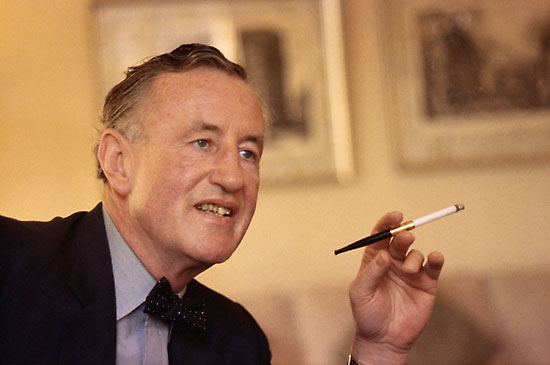
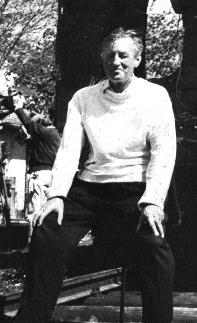
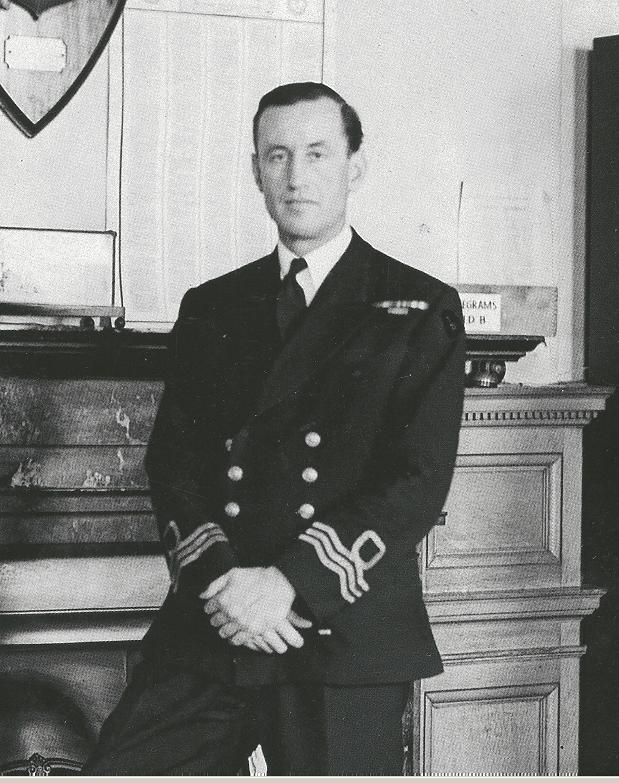

As indicated above, and what may be true of many faddish and manic interests, a combination of events led to the popularity of this movie. Chief among this is the author, Ian Fleming, who did much to publicize his work. All authors, except possibly for J.D. Salinger, attempt this but Fleming was in a unique position. The 1950's precluded information about World War II operations from being disclosed both in the United States and in Britain. However, Fleming had a front row seat in this as he had served as the assistant to the chief of naval intelligence in England during the war. A loophole that he exploited, as did others, was in being able to fictionalize these events. This gave him a tremendous amount of material for his books which were written between 1952 and his death in August of 1964, just before the release of this movie, as indicated above. Furthermore, for whatever reason, mention of secret (and spying) services in both Britain and the US was frowned on by each government and the factual press was pressured to ignore these subjects. This gave Fleming a free hand in the manufacture of the aura of these secret services which he usurped to the maximum. For more information on this, several recent books have appeared discussing this very subject and the most astute interpreter of this phoenomena is Nigel West whose lectures can be seen at www.nigelwest.com.
Besides this free hand in the above matters, Fleming had a great handle on what would generate publicity for him on a tangential level probably because of his experience in journalism. There are many pictures of him aiming revolvers and yet his experience with such armament was very limited. He tooled around London in the latest sports cars from the United States including an early Thunderbird and his favorite, a Studebaker Avanti, and he made sure that there was enough photographs of this. Publicity as to the special Turkish blend of cigarette he smoked is an example of Fleming at his best. It is said that when he contracted the deal that gave Albert Broccoli and Harry Saltzman the rights to make movies from the books, that he arranged to meet these two at midnight somewhere on the west coast just to add to the effect. Broccoli and Saltzman would form a partnership, Danjaq whose solely owned subsidy, Eon productions, produces the Bond films. Broccoli would later buy out Saltzman and become the sole owner of this franchise.
Fleming's death at the age of 56 on August 12th, 1964 would be splashed around the world. Given that this death occurred at the Royal St Georges Golf Club put an interesting spin on this as he used this golf course as a model for the ficticious Royal St Marks where James Bond and Goldfinger match wits during a round of golf. This match is one of the dramatic elements in the book duplicated by the movie. Almost all of the publicity per his death mentioned this fact which aroused interest of many when reading his obituary. In addition, many of the "Red Herrings" that Fleming carefully planted about himself throughout the years were reported as fact which no doubt would have given him a chuckle if he would have been alive.
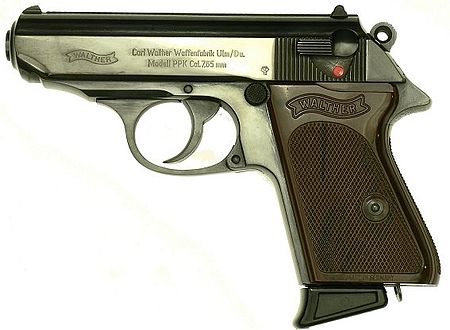
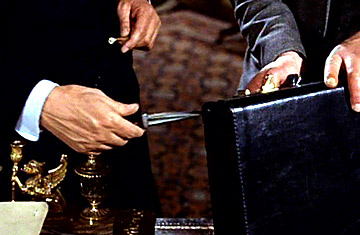
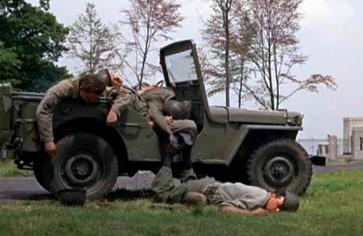
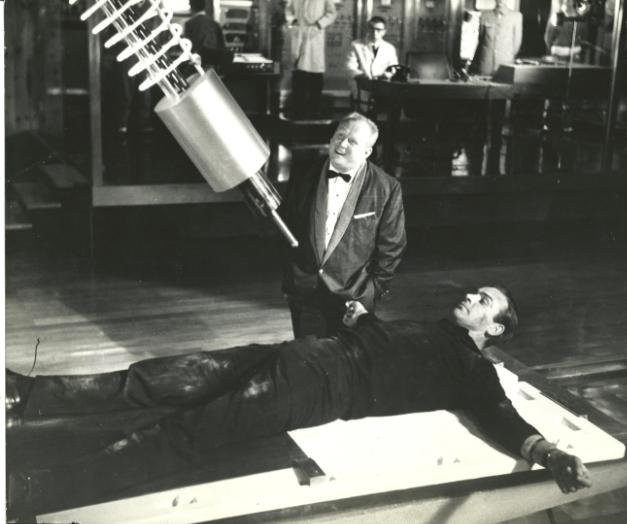
The use of technology also can not be discounted per the popularity of this author and his books. In the first of the movies, Dr No, an armorer delivers a different revolver to Bond in M's office. This was consistent with the books when Bond returns to his service after near death as his gun jams at the end of From Russia with Love. It was reported that Fleming had been in contact with a small arms expert and was finally getting Bond's armament right. The first movie picked this up without adding the context in which this occurs. By the next movie, From Russia With Love, as in the book of the same name, a nifty brief case was presented to Bond as he starts his assignment. In the book the brief case contains extra money and a knife. This gets souped up in the movie to include a rifle and a canister of tear gas. Goldfinger was set to make more leaps into technology beyond what the book discussed.
One of the things Fleming never got credit for was his prescient use of these things. Moonraker, which involves a plot to A-bomb London may have been the first work of fiction to specifically deal with such a peril. One of the aspects of Goldfinger revolves around the attempt to poison Ft Knox's water supply (this gets changed to the use of an aerosol spray in the movies). In another book Fleming deals with biological agents, such as Anthrax and Thunderball returns to a nuclear threat used to blackmail Nato. Both books and movies established this pattern and part of the movie-going experience of the early Bond movies was to watch this technology in action. One thing we should indicate is that in the books Bond is never threatened by a laser. This was added at the appropriate spot in the movie where Goldfinger uses a circular chainsaw in the book to threaten Bond.
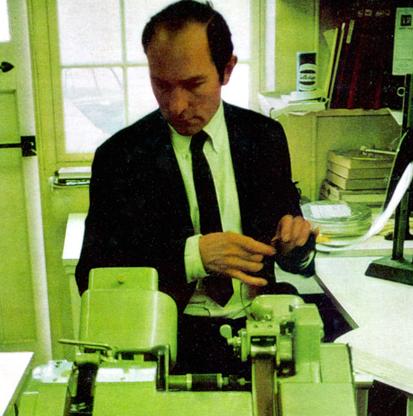
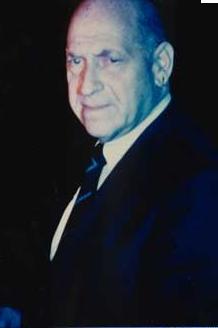
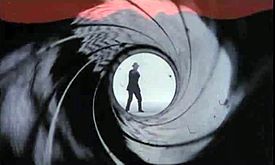
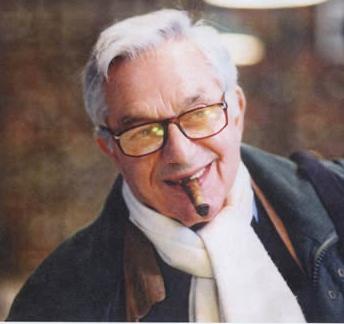
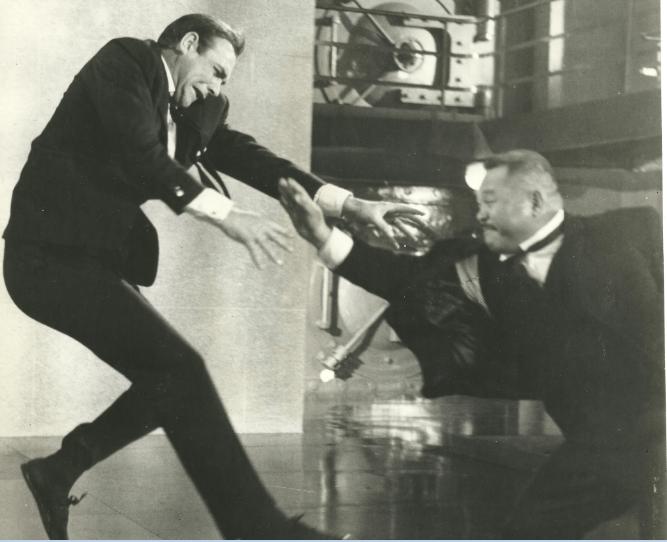
At this point we should mention that Eon productions had amassed a versatile ensemble of technicians to produce these movies. One was alluded to previously, the film editor, Peter Hunt who again acted as such for this film and would return to be director of the sixth movie, On her Majesty's Secret Service. He was the one who had pioneered the use of quick transitons and wipes between scenes that characterized the quick film movement in the first few movies and if you are interested in a technical discussion of this, click here.. Another returnee in a sense was Maurice Binder, a movie title designer, who, for the first James Bond movie, Dr No, had created the signature first few scenes now known as the gunbarrel sequence. The gunbarrel sequence would return but Binder would be replaced by Robert Brownjohn in the creation of Goldfinger's beginning and ending credits. But, the sets and special effects, such as the deadly extensions of the car and the interior of Fort Knox as represented by the movie, were the brainchild to some degree of Ken Adams who was the production designer of the Early Bonds. Adams was a German refugee who came from a rather prominent Jewish family in Germany which lost everything as they fled to England prior to the war. Perhaps this insecurity was channeled into taking relatively everyday objects like briefcases and cars and transforming them into weapons.
And so, with this team intact, it is sometime late in 1963 that the producers turn their attention to the filming of Goldfinger and have screenwriters prepare first drafts. But, Goldfinger, had been very successful as the 7th book of the James Bond thrillers written in Early 1958 and published in 1959. It is also somewhat unique as to the villian whose appetite for all things golden makes him something of a modern day Midas.
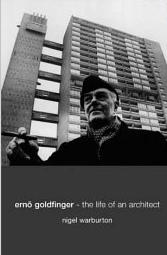

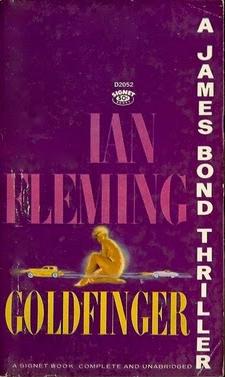

For those studying Fleming's life, Fleming's interests and activities generally got translated into books. Casino Royale, the first novel, revolves around Fleming's interest in Gambling and attempts to duplicate something he was involved with during a trip to Portugal during WWII. The 4th novel, Diamonds are Forever, is placed in Las Vegas given Fleming's trip to this mecca in the early '50s for business. A trip to a guano island in Jamaica becomes the basis of Dr No and discussions as a journalist with supposed KGB informants become the basis of From Russia With Love. A series of visits to cities, done as a journalist that would eventually create 'Thrilling Cities' provides material for You Only Live Twice. One can assume that Fleming had become interested in the financial aspects of gold and the result was Goldfinger, the book. But what about the title name. Just a cursory reading of Fleming's works indicate a fear and mistrust of most Germans and this would be realistic of a writer whose lifetime would have seen two World Wars started by that country and who had lost a father to the first of these wars (Valentine Fleming, Ian's father, was killed in 1916 when Ian was eight). Except for two villians, all are either fully German or half German including Dr No, the son of a German missionary and Red Grant, the son of a German circus strongman. The two villians that aren't German are Francisco Scaramanga, the villian of 'The Man With The Golden Gun' and Auric Goldfinger who is described in the book as of Balkan, probably Jewish, origin. Goldfinger's dealings with governmental officials is also unique, very different than the manner of Fleming's other villians. All the villians have great egos to be sure. None doubt their ability. But Goldfinger is demonstratably comtemptuous of authority.
In this, Fleming's ability to mimic and understand personality got his publisher and himself into trouble. It is clear that Fleming modeled Auric Goldfinger's personality, origins and small stature on the extremely tall architect, Erno Goldfinger (and if you are interested, a new book on the Architect Goldfinger has been published recently as indicated in the left most picture above). The architect recognized this and threatened suit prior to the book's publication. Although there was plenty of animosity to go around and Fleming even threatened to rename the character, Goldprick, peace was eventually restored when the publisher of the book, Jonathan Cape, agreed to include a startment in the forward that the book represented fictional characters and in no way depicted anyone alive (or dead). In this, the book Goldfinger, established the precedent of such statements for books of fiction. And, however difficult usage of a name like Goldfinger might be, think of the problem in 1964 America as this movie is produced, just at the end of the censoring of movie content, of using a name like Goldprick in a movie. We should however indicate, from the architect's standpoint, that this period could not have been easy on his ego given that the book was a best seller in England and everyone reading it was aware of his threatened lawsuit given the publicity.
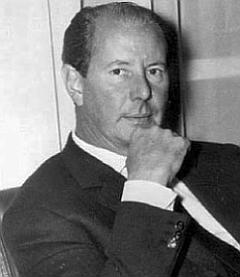
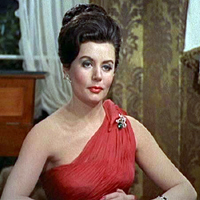
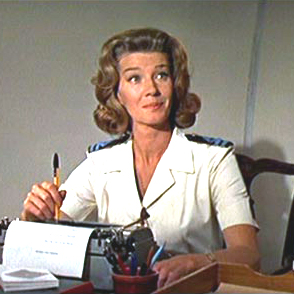
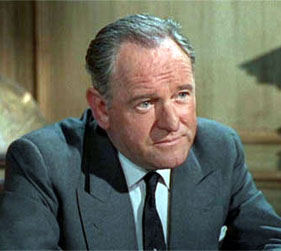
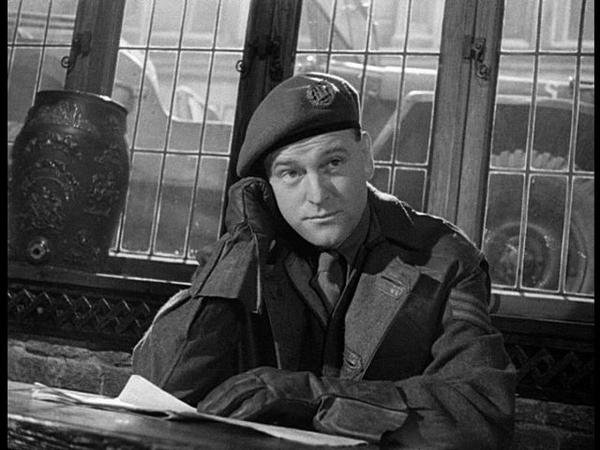

The above problems involving Fleming, his publisher Jonathon Cape and Erno Goldfinger do not affect the screenwriters in late'63 as they attempt to transform this book to the screen. With two successful films already in this franchise, the screenwriters have a successful formula to follow. Bond beds so many girls, has so many near misses, orders so many martinis (shaken but not stirred) and introduces himself as 'Bond, James Bond'. The early films, under the director Terrence Young, also attempted to humanize the character and a somewhat steady girl friend, Sylvia Trench as played by Eunice Grayson, made a limited appearance in the first two movies. There would be the required banter with Miss Moneypenny (as played by Lois Maxwell) as Bond steps into M's outer office not to mention the official briefing with M (as played by Bernard Lee who was a very famous actor in his own right having had a large part in 'The Third Man' which was considered the archetypal spy movie prior to the Bond series) as Bond is assigned his case. A respectful Q (or Major Boothroyd, named for the small arms expert indicated above who had correspondence with Fleming, and played by Peter Burton in Dr No and, as a recurring role thereafter, by Desmond Llewelyn in From Russia With Love) who would politely arm Bond for this next assignment. Much of the movie Bond persona of the early Bond films had been created by the director of the first two movies, Terrence Young, who was apparently a major influence in the selection of Sean Connery (Connery was a bit player in a movie 'Action of the tiger' that Young had directed five years before Dr No) and continued that influence by taking Connery around to various clothiers so that he would look the part. In an interview in November'63, Young talks about his preparations for the third of the Bond movies, Goldfinger, which at that time was supposed to be filmed in Portugal.
But, this was not to be. Young made a demand of the producers, Broccoli and Saltzman, of sharing in the profits and was handed his walking papers. Come 1964, another director, and to some degree, another direction was to be taken.
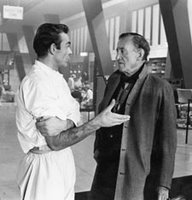
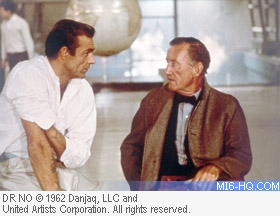
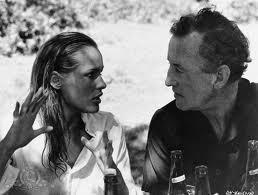
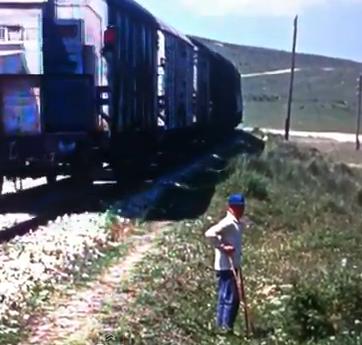
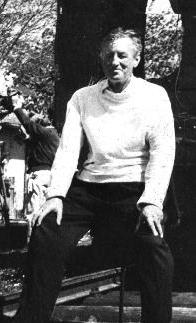
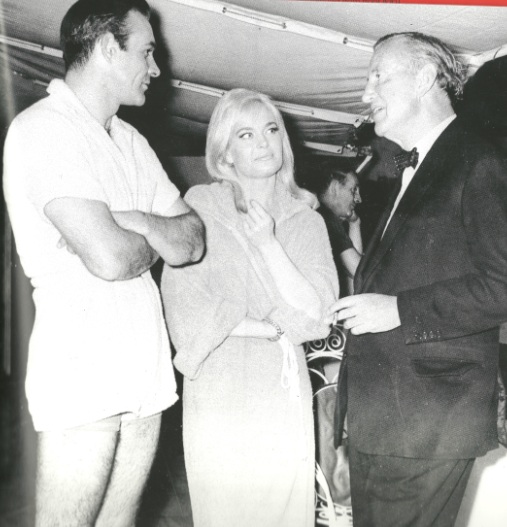
And so, the initial pre-production work falls to newly appointed director, Guy Hamilton, and the cadre of technical support indicated above. Pre production is done in Miami and over the depository at Ft knox where permission is obtained for fly-overs for photographic purposes. Sets are built at Pinewood studios outside of London and the actors report to these sets early in March. James Bond, at this point, is becoming a mania and the press, both in England and the US, report on the progress of the filming. Various and many interviews with Sean Connery are in the works and this probably plants the seed of his unease with his notoreity as the embodiment of James Bond. No doubt being injured in his fight scenes with Howard Saketa (Oddjob in the movies) didn't help the situation although the raise he got from the producers did have a calming effect.
Besides the change in directors, one other thing had changed in the filming of this movie versus the previous Bonds. Except for one week in Switzerland, everything is done on the movie and sound stages at Pinewood. In the previous movies, large amounts of production time were spent in Jamaica and Turkey, respectively. In fact, enough time, for the author, Ian Fleming, to visit both locales to view the process of filming of each of those movies. To be fair, Fleming didn't have far to go per the filming in Jamaica as much of it occurred just outside of his residence, Goldeneye, on the North shore of the island while he was in residence there. In addition, for both previous films, Fleming also visited Pinewood studio and on each visit was photographed holding conversations with Connery no doubt about each one's interpretation of James Bond, for one as alter ego, the other as portrayer. For Goldfinger, the only visit by Fleming is to Pinewoods in the midst of filming. It must have been obvious that he was a very sick man and one doubts that anyone was shocked by news of his death within a few months. But, the meeting of the creator and portrayer created a whirlwind of publicity for a movie that already was hyped to the hilt.
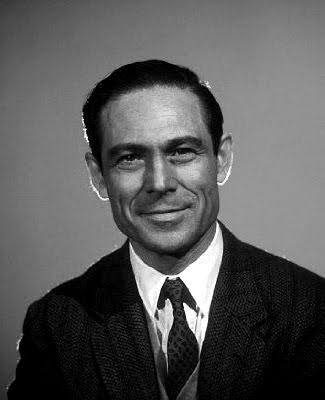
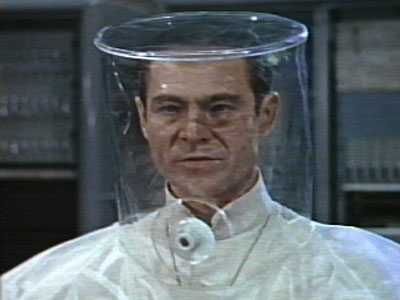
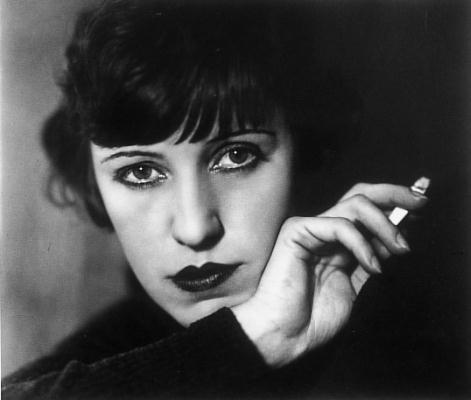
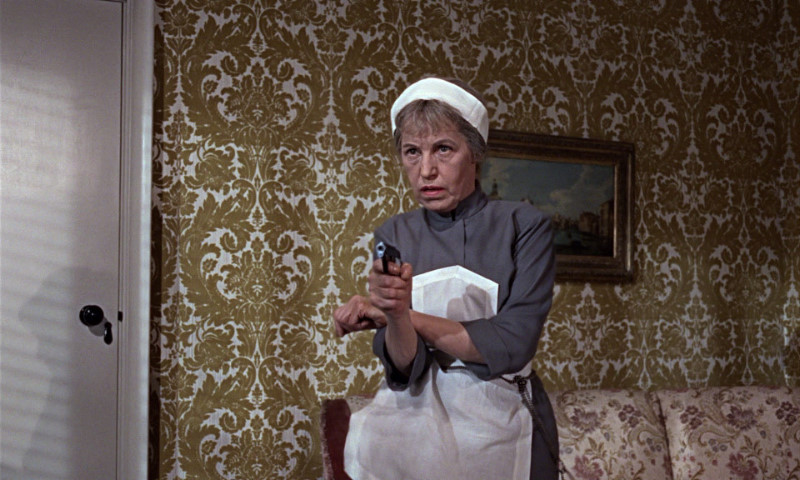
How about the actors themselves. There could not have been any question of the publicity an actor would receive being in a Bond movie at that point and in some cases this was a detriment. The two chief villians of the previous Bond movies, Joseph Wiseman, who had portrayed Dr No, and Lotte Lenya, who portrayed Rosa Klebb, had already been vocal about this. Wiseman, who died in Oct 2009 at age 91, was a well known Broadway actor and took his craft very seriously. The fact that any interview would start with a question about his role as Dr No appalled and insulted him to the point that he would grant no interviews if this subject was to come up. What started as an easy role with a financial payoff became, in Wiseman's opinion, one of the worst decisions he made about accepting a part.
Lotte Lenya was famous when in Germany before WWII as she was married to the famous songwriter/composer Kurt Weill. She (and Weill separately as they had by this time divorced) fled Germany in 1933 and worked her way to the United States during the later 30's where she remarried her ex-husband. Similar to Wiseman, she acted quite frequently on stage but as opposed to Wiseman, she did have a singing career. One would consider her well known even before playing Rosa Klebb in From Russia With Love. But, once From Russia With Love hit the screen, it didn't matter what her previous fame or how many Tony's she had won or what parts she had originated or even her interesting marriage/divorce/remarriage. Now, most people she met had but one interest of her: Show them how her poisoned shoe worked in the fight with Sean Connery at the end of the movie.
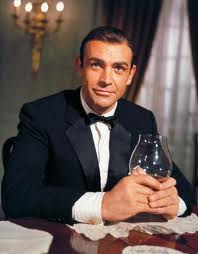
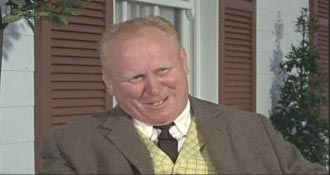
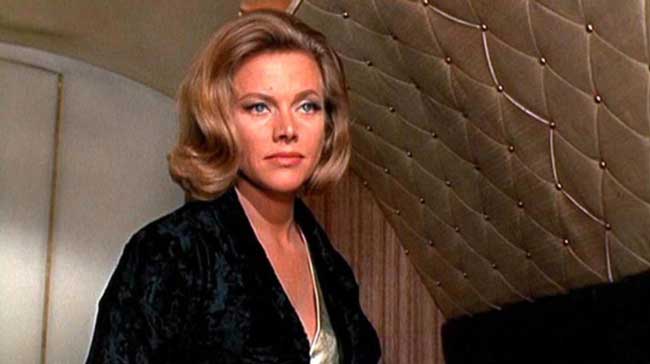

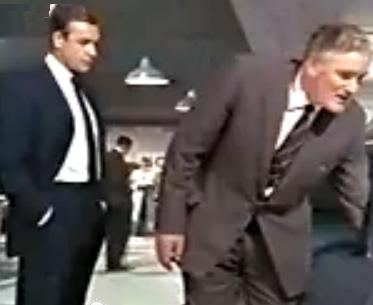
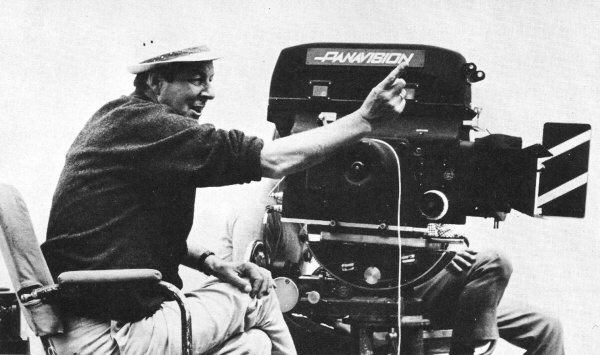
So this noteriety was a given as the actors congregated for the movie. Thomas Sean Connery, who had dropped the Thomas and used Sean for acting purposes, again played secret agent 007. Cast as the main villian was Gert Frobe who did not speak English. While he mouthed the words, his voice was dubbed throughout the movie. A secondary villian who becomes the heroine is played by Honor Blackman who had become famous in England playing the role of Cathy Gale opposite Patrick MacNee in the Avengers. In another of the many controversies that would engulf Goldfinger was Blackman's role's name:she played a lesbian named Pussy Galore. For the books, such a name could be used but movies in the United States (and possibly in Britain) were not looked at having the same free speech rights. In fact, it was only in 1952 in the United States that any type of first amendment protection was extended to movies but the practice was still to avoid controversial or extremely sexual situations which her character's name promised to invoke. While the movie had the actors calling her Penny in the script, in the end the name Pussy was dubbed in before the movie was released to the public. And, if her character's name was questionable, you can imagine how the story line of the movie skirted her character's sexual preferences. The last of the main actors was Goldfinger's henchman, Oddjob. In the book and the movie he is an extremely big and lethal Korean martial arts expert and the role was filled by a popular wrestler in Britain at the time, Harold Saketa (although his wrestling name is also provided in parenthesis in some of the credits). Saketa was an American Olypic weightliter who was born in Hawaii and became a professional wrestler popular in Canada and England. All of these actors, and more, performed on the English movie and sound stages at Pinewoods under the direction of Guy Hamilton as if they were in the United States atttempting the greatest robbery (or at least a type of robbery per the movie) of all time.
In addition, you had the actors returning who had played M, Q and Moneypenny from the previous Bond movie, From Russia With Love. But now, the changes of the new director come into play. The interplay between Bond and M and Bond and Q are more adversarial than comrades-in-arms. And, Sylvia Trench is nowhere to be found. And what becomes known as the red herring, the scenes before the titles, tells you that a new hand as director is on the throttle as Bond peels off a camouflage wet suit to reveal a tuxedo underneath. All of this is picked up by the press in one way or the other and fed through many different channels to a waiting public.
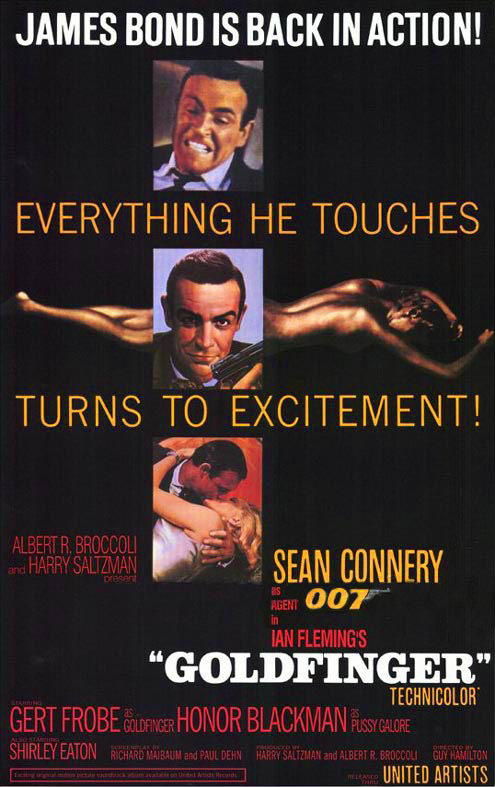

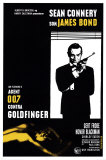
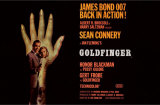
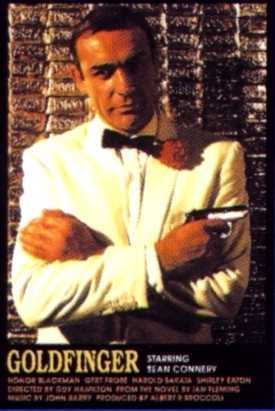
Anyway, from the above discussions, you should understand that the demand for this movie was evident long before it opened in the United States. The movie was preceded by a type of media blitz. For Dr No, the publicity was that this hero was licensed to kill whoever and whenever he wanted which certainly was not the duty of the literary Bond as writen by Fleming. For From Russia with Love, the hype was that 'James Bond was back'. For Goldfinger, three distinct threads ran through the themes of the publicity. One was that 'James Bond is back in action'. A second one proclaimed that this hero was 'licensed to thrill'. And a final one was a play on the Midas mythology proclaiming that 'everything he touches turns to excitement'. These blurbs were hyped through posters and pamphlets that we have duplicated above and for this web script we have copied the black background and gold lettering motif. The naked face down golden girl (Shirley Eaton) that you can see in many of the posters above becomes another icon of this movie
In addition the album was released early and Americans became aware of another British Export, Shirley Bassey, as indicated above. Nicknamed the Tigress of Tiger Bay (where she grew up in Cardiff, Wales), Bassey was known as a singer with very strong vocal chords and range. She could really belt out a song. Her life story was also interesting. A product of a Nigerian father, she faced discrimination in England as she grew up. While singing somewhat professionally until 15, she became pregnant at 16 and spent time in her teens waiting on tables. Luckily, her talent was recognized and by the end of the 50's she was a legitamate singing star although not known in the US (although research does indicate that she appeared in Las Vegas several times). That was to change with Goldfinger whose melody and lyrics melded perfectly with the times and the aura of this movie. It was not unusual to hear this song being played on pop stations and it is said that it did reach #3 (some say #8) on the top 40 list at one time as a single and the entire Goldfinger movie album was #1 in sales for a stretch. Note: An additional script has been prepared dealing with the early Bond movie music at this link
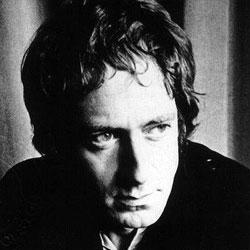
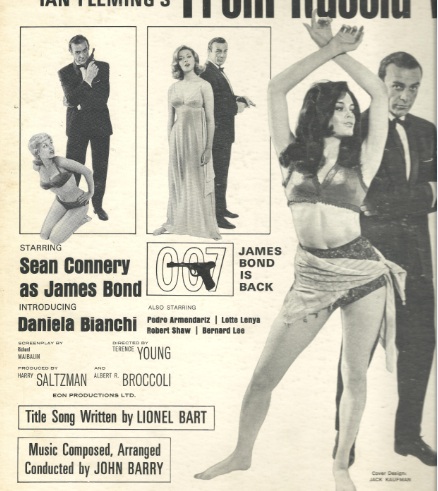
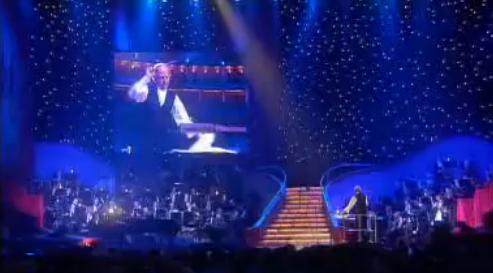
How Bassey gets to sing this is a story in itself. In early 1964 she is touring England and her act includes a live band and a musical director whose job is to both arrange and orchestrate the selections with her voice and the band's instruments. She has done well to pick one of the foremost musicians in England, John Barry, four years older than her (she was 26 at the time) as this director. John Barry Prendergast was the son of a family that owned multiple movie theaters. He is an avid musician as a youngster and becomes proficient in both the piano and trumpet it is said. After serving in the military, he drops his last name and immerses himself in jazz creating a band, the John Barry seven, that specializes in this type of music. However, being an avid musician, he is also interested in how to manipulate themes and by 1960, or so, is arranging music (and this would be background and accompaning music) for movies and on limited occasions is composing title songs. One of his early works involves the movie, 'The L-shaped room'.
However, when the movie version of Dr No was originally conceived several years previous, the producers engage a then more well known musician, Monty Norman, to compose the major theme and the accompanying and background music for the movie. As the movie will take place in Jamaica, Norman visits the island (apparently on the same plane carrying Sean Connery) to pick up native rhythms and sounds. His theme song, called the James Bond theme, lacks the oomph the producers are looking for. In some way, they turn to Barry to redo the theme music and the result is what you hear overlaying the titles of Dr No, what we now know as the James Bond theme. Although you sometimes read that Barry and the John Barry Seven went uncredited in the titles, a recent viewing of Dr No shows otherwise with the credits indicating that the James Bond theme was performed by John Barry and Orchestra. Uncredited, but of especial importance, is Vic Flick of the John Barry Seven as it is his guitar work that really gives depth to the music.
From this point, the James Bond theme would be credited to Monty Norman although Barry would take pains to indicate this music as his own. 30 years later a court case convenes to determine who really can take credit for this, Norman or Barry, and the ruling is that the music should be credited to Monty Norman as it had been. Nevertheless, whatever the credit, the producers are pleased enough to invite Barry back for a second go-around when Lionel Bart, hired to create the theme for From Russia With Love, cannot produce the needed accompanying music off of his compilation. This time credited for everything but the title tracks, Barry produces a great accompanying score and even adds a secondary adventure theme by writing what is now known as the 007 theme. You can hear this in that movie during the fight in the Gypsy camp and again in the fight within the Russian embassy.
The third time is the charm as the producers give a free hand to Barry for all aspects of music for the movie, Goldfinger, and while accompanying Bassey around England, he spends late hours writing what would become one of the best known movie themes ever created. One night he plays a portion of what he has written for Bassey and she agrees on the spot to perform this even though the lyrics had not been written. This is resolved when Anthony Newley and Leslie Bricusse, famous in their own rights for theatrical and performance music, are contracted to write the lyrics. Sometime later in 1964, supposedly the London Philharmonic meets with all these parties to record the music for this movie. There are many high points - both literally and conceptually - in the Goldfinger movie theme but a major high point is at the end where Bassey holds the ending notes. Depending on who's telling the tale there are two stories that we can relate on how this was accomplished.
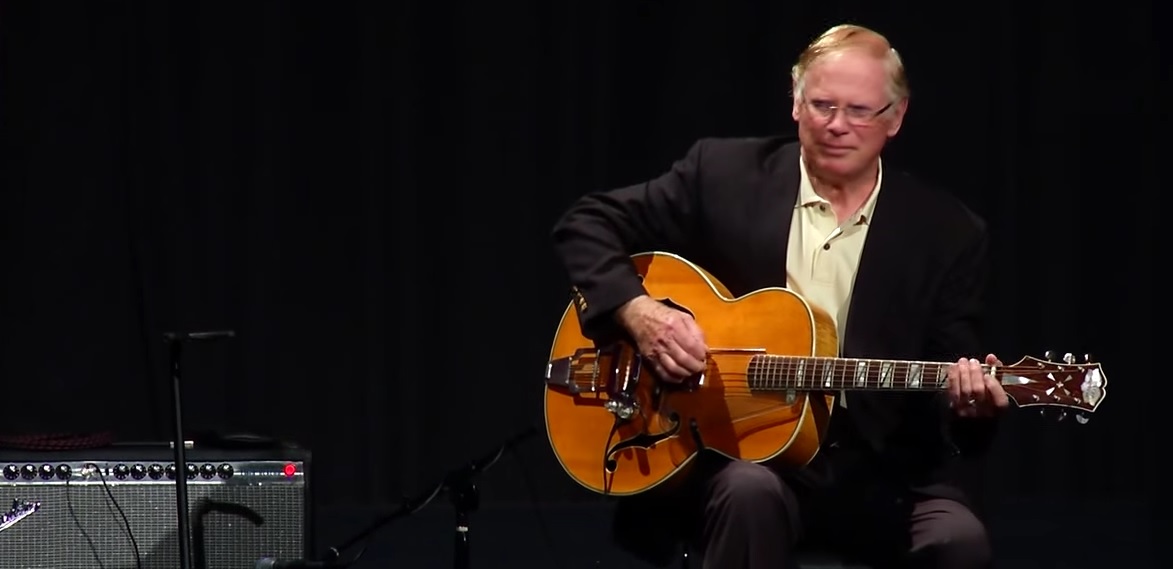
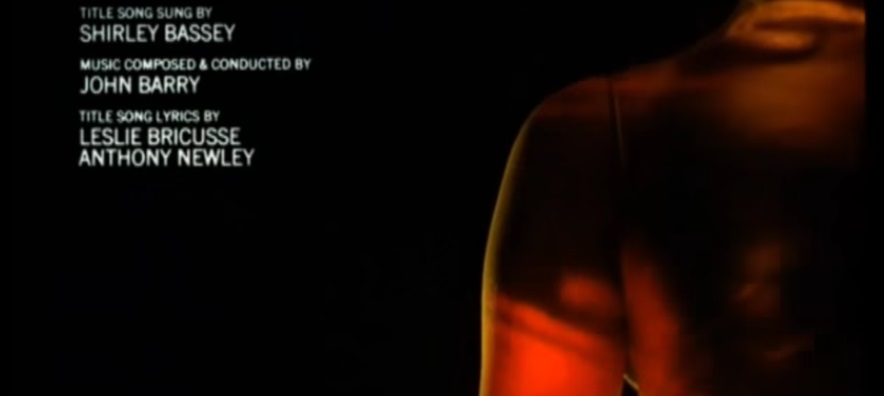
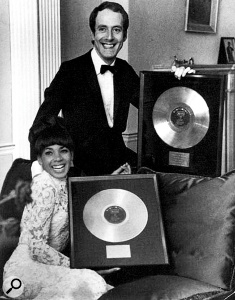
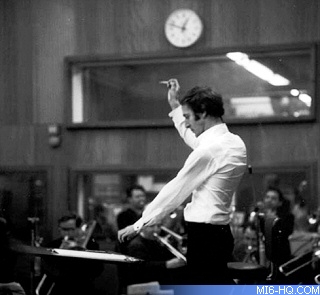
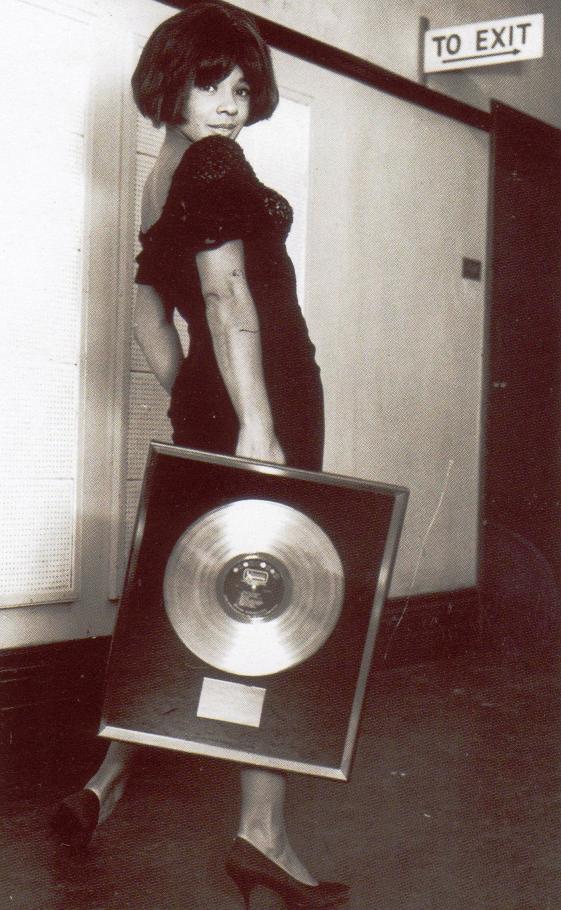
Per Bassey's memories: All is set except for one little detail: Barry has instituted a change of which Bassey is not aware. The orchestra will be instructed to hold the notes at the end to stretch out the time duration of the title song. What you are hearing at the end of the title theme is panic in Bassey's voice as she struggles to hold these notes unexpectedly but she is such an accomplished singer with such great lung capacity, that all goes well and this becomes another iconic moment of this film and one that is recognized instantly.
Per Vic Flick's memeories: Apparently there was some kind of sound control room where Flick is sitting next to John Barry. Outside this studio Bassey is singing the title song accompanied by the orchestra. Several takes have already been attempted and Barry just is not satisfied with Bassey's vocalization. He switches on his mike to ask her to again perform the song but with more oomph at the end. Her reply is two fold as Flick relates. An angry retort to the effect that she'll sing this just one more time followed by a toss of her bra directed at Barry and Flick in the control area. Obviously the decreased pressure on her chest allowed her to create the rendition of Goldfinger that would become one of the musical icons of the 60's. Note: You can see Vic Flick play the James Bond theme using the same guitar as he did in the movies by Clicking here.
Anyway, record crowds, and some rioting by those who could not get in to view it, had occurred when the movie opened in England in September. Later, police in South Africa used water hoses to quell the crowd that had amassed to see the movie opening in Johannesberg. New York was ready with its own solution when late December (particularly the Dec 21 through Dec 23 period) rolled around.
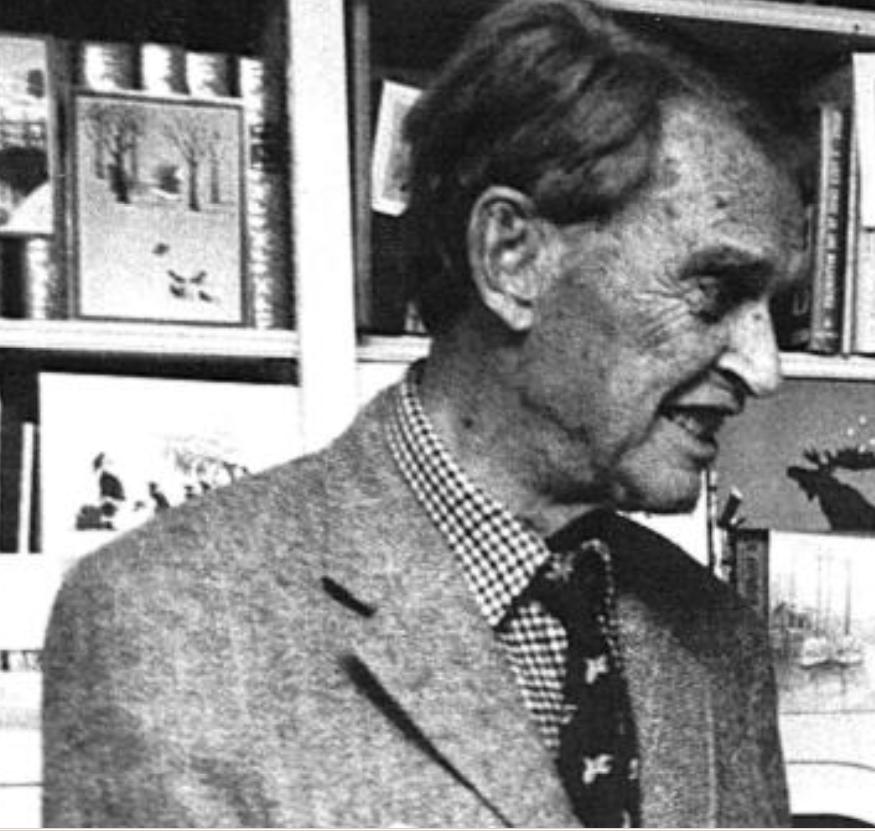
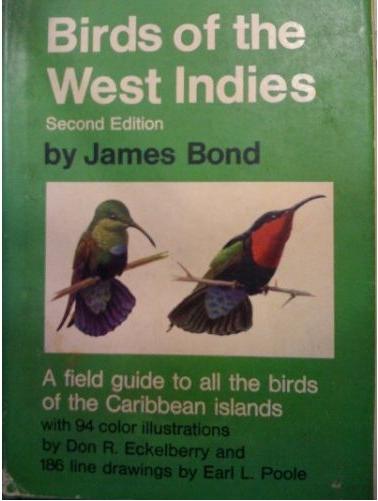

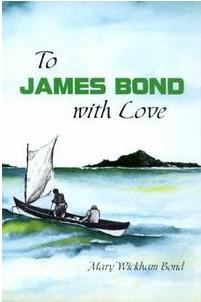
We have indicated that there was a great demand to see this movie and tremendous anticipation for its release. There are, however, at least two people thinking otherwise. One is the architect, Erno Goldfinger, mentioned above, who already had to endure the written representation of his persona several years before as the book was published. What could he have been thinking as he prepared for a second go-around, this time visual? But, how about the individual Fleming claimed he used for his creation's name? The ornithologist, James Bond, who worked at the Academy Of Natural Sciences in Philadelphia had already endured plenty of disruption based on Fleming's claims. This Bond was the author of 'Birds Of The West Indies' and Fleming claimed that he usurped that book's author's name as he searched around for an appropriate moniker. Many, including this writer, discount this tale by Fleming but nevertheless this focused attention on a very private individual. Professor Bond and his wife. Mary, already were enduring crank calls at their home as a result of the first two movies and an irate Mrs Bond was already in contact with Fleming about this in a series of correspondence. This eventually led to the one and only meeting between Fleming and the Philadelphian Bond (and his wife) early that year and both men found that they enjoyed each other's company as related by Mary Bond in her book(s) about this. But, nevertheless, it would be a reasonable assumption that the Bond's were apprehensive about even more crank calls prior to the release of this movie.
In those years, and we're sure this practice continues today, it was the norm to have a invitation only preview of movies for the movie critics and celebrities. Some of these events were charitable affairs with the proceeds so distributed. Early that month in New York, December 1964, a preview of this movie must have taken place before a select group of invitees. We know this because the buzz from these participants was another source of fuel to the anticipation of the offical opening of the movie. To give an example, NBC radio had created a weekend programming schedule designated as Monitor running a few consecutive hours 3 times on Saturday and Sunday and each time with a different host. Very similar to what is now the programming of Morning Edition and All thing Considered on NPR. As indicated, various NBC celebrities would host this show throughout the weekend. One such host, Gene Rayburn, host of the Match game (a game show on NBC at the time), commented very favorably on Goldfinger, before its official opening, just after he had been to the preview while on the air after the Monitor program he was hosting had played Goldfinger as sung by Shirley Bassey. It would also be apparent to any casual observer that the movie critics had also attended as the opening day advertisements were accompanied by reviews. We are pained to inform you that most critics were somewhat negative in their views as they felt that the lightness, directness and good fun of From Russia With Love was replaced with something a little darker and campier. But it is doubtful that any would be film-goer was deterred by any review.
Well, everything came to fruition on Monday, Dec 21st, 1964 as Goldfinger opened up at least in New York. Most of the US would have to wait until early the next month to see this movie when distribution extended throughout the whole country. In New York, two theaters, the Demille and the Coronet were scheduled to show this film. In those days, theaters were designated as prime (first run), secondary and tertiary. It was not as it is today where a picture can open on 3000 screens across the country on the first day. A run of a few weeks was first set for the primary/first run theaters. After a few weeks, the film would move to the secondary theaters. A few weeks after that, it would be general distribution by way of the tertiary theaters. However, in 1964, the New York area opening for Goldfinger would be confined to only two movie theaters offering this film for the first few weeks. In the Philadelphia area, a similar limitation would be imposed and memory indicates that the Midtown theater was chosen to first-run Goldfinger. (Although it appears as we work on another script for this series that the Goldman theater at 15th and Chestnut was where Goldfinger opened up in Philadelphia although we still feel that the Midtown was in some way a part of the initial film distribution in Philadelphia but the use of one's memory can always be found to be fallable).
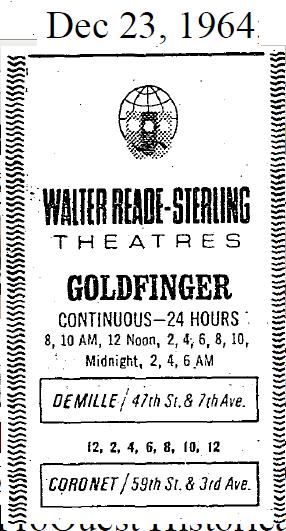
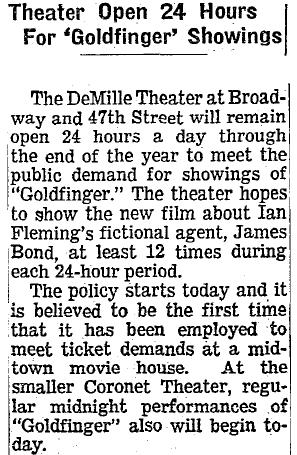
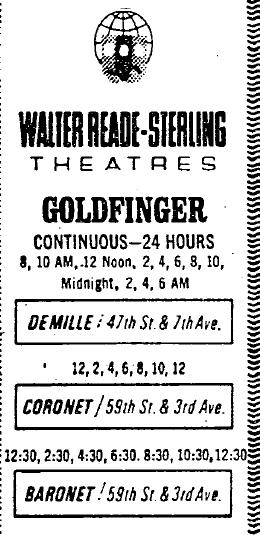
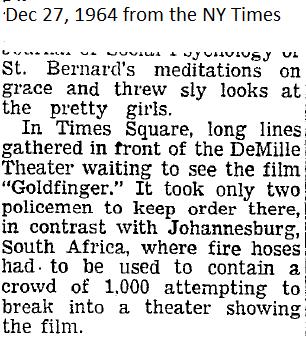
While riots, as seen in other countries, did not occur, there certainly was demand which was indicated by long lines of people waiting for a chance to see this movie. Some would be disappointed with long waits only to be turned away. By Dec 23rd, changes were afoot. A third movie house was added, the Baronet, and for the first time that anyone could remember, this movie, Goldfinger, was shown on a 24/7 basis, something we take for granted today at movie complexes. Above, using the NY Times database, we track the newspaper coverage of this to some degree. Continuous, and the two hour time slots that go around the clock, is the wording in the movie ads as you can see from the Dec 23rd and Dec 31st advertisements. The two hour cycle was made possible by the movie length of 112 minutes. This gave the theater eight minutes to refill the auditorium which must have been pushing it. Another interesting fact was that Goldfinger probably claims the record for making back the production costs in record time and this only counts this country. The movie was produced for 3.5 million dollars and this was recouped in the United States alone within 6 days it is claimed.

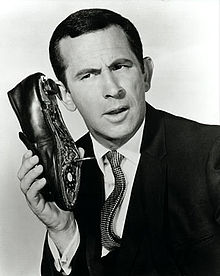
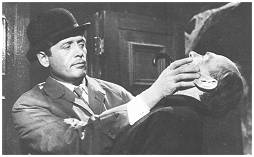

The media coverage of this movie was a forerunner to the block busters of today such as Harry Potter and Avatar. Besides coverage in the news as to the demand, Goldfinger was mentioned or alluded to for a long time. Multiple spy movies were created to imitate this genre and spy oriented TV shows became somewhat the norm. We had alluded to a name above and that name, Napoleon Solo, besides a bit character in Goldfinger who dies by various means at the hand of Oddjob, would be the name of the hero in 'The Man From Uncle' which debuted in Sept'64. In 1965, Get Smart, a parody of Bond, written by Mel Brooks and Buck Henry, would have Don Adams acting as agent 86. At several locations on this web site, in the discussion of the 13 series of CDs, is a discussion of Patrick McGoohan and his metamorphosis from the agent John Drake to Prisoner #6. If in television the highest form of flattery is imitation, James Bond was much appreciated by the entertainment industry.
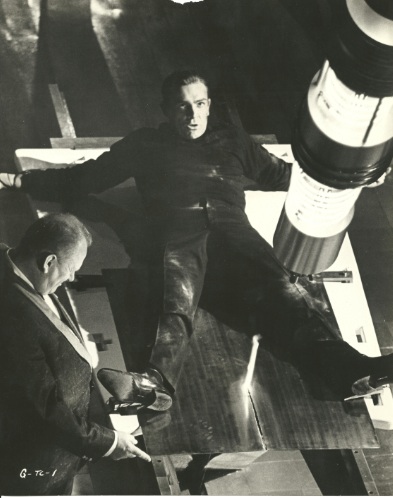
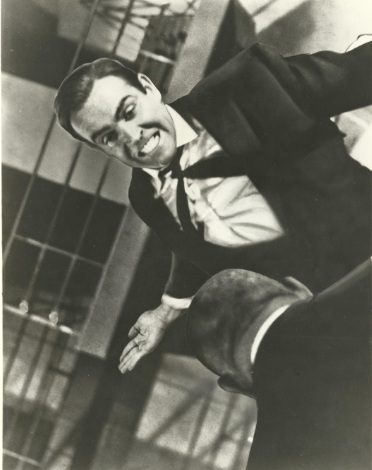
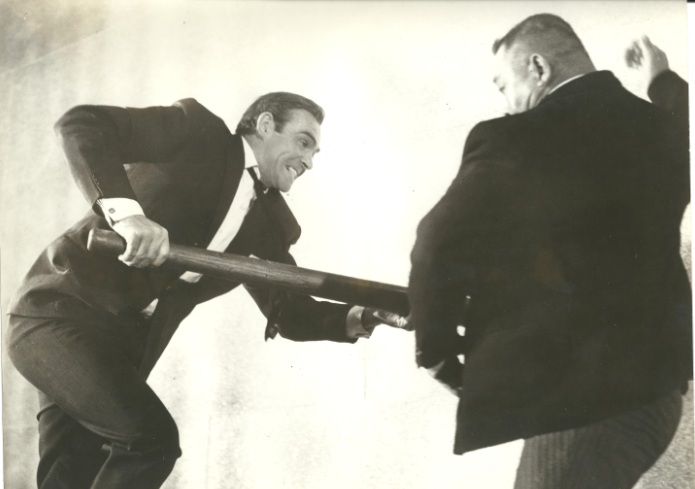

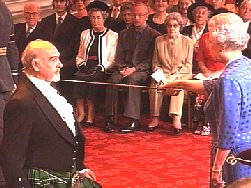
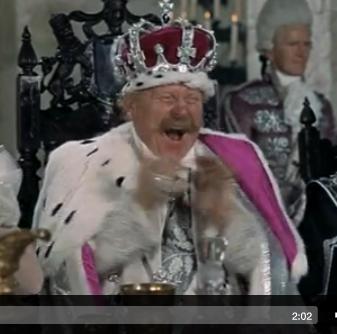
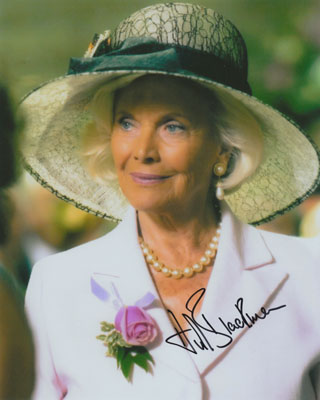
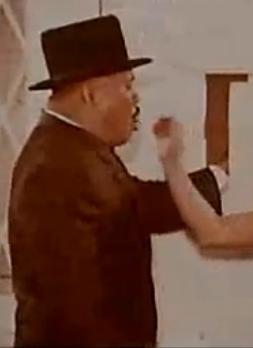
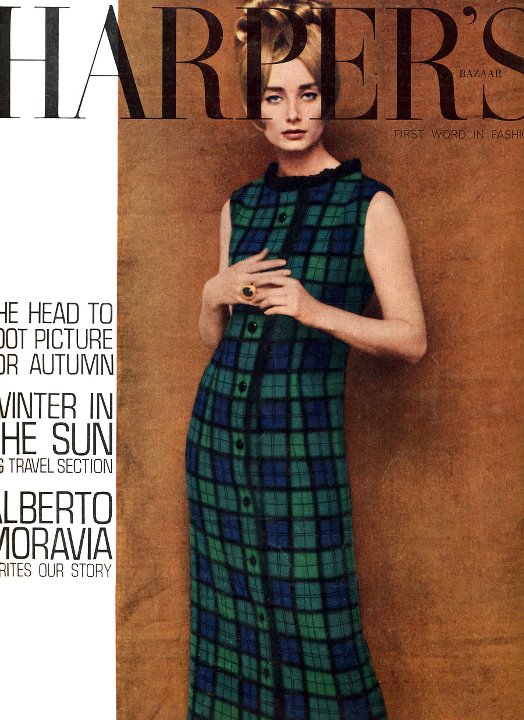
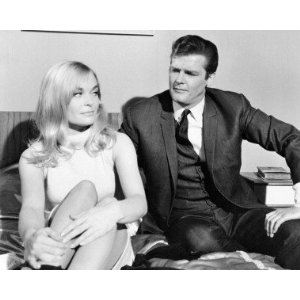
As for the movie Goldfinger, the actors in this movie became famous and household names. For one, as we will see, it brought back some memories from World War II that was not expected. Everything seemed golden as far as the Bond Mystique was concerned. The stills from this movie, supplied by United Artists, the movie distributor, showed up in every magazine and publication. We duplicate some of these in the first row above. In looking at these pictures, Goldfinger with the laser and Bond fighting Oddjob in the vaults of Fort Knox, keep in mind you are looking at genius on two levels by two individuals, Ian Fleming for thinking this up in his novel of 1958 and Ken Adams for his film design. Adams was knighted in 2003 for his work in set design in the creation of sets such as these for many movies. Sean Connery would later leave the Bond series and become a well known actor for many roles and was knighted for this work in film in 2000. Gert Frobe would get a second chance at being in an Ian Fleming infuenced movie when he appeared in Chitty Chitty Bang Bang a few years later. Honor Blackman would appear in many movies and TV programs in a career that still is going somewhat strong. The most interesting movie appearance was a few year later in Shalako starring Sean Connery. It seems as if Harold Saketa never returned to the ring concentrating on acting instead. A few years hence he would be involved with another Fleming inspired script, 'The Poppy is also a Flower'. Perhaps you also saw him in the famous Vicks cough medicine commercial where he destroys a neighborhood with a supposed nasty cough until the Vicks settles him down. Finally, both the actresses who played the Masterton sisters retired somewhat quickly from acting. Tania Mallet, who played Tilly, killed in the film by Oddjob's bowler hat, returned to modelling; Shirley Eaton, the golden girl, had been successful prior to Goldfinger but her career fizzled out after although she did do several Saint TV shows with a future James Bond, Roger Moore.
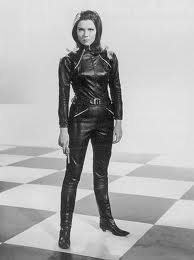
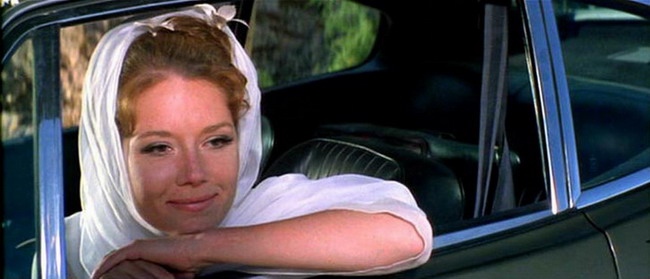
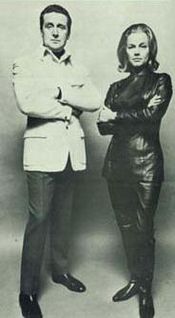
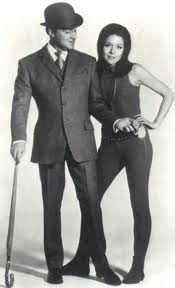
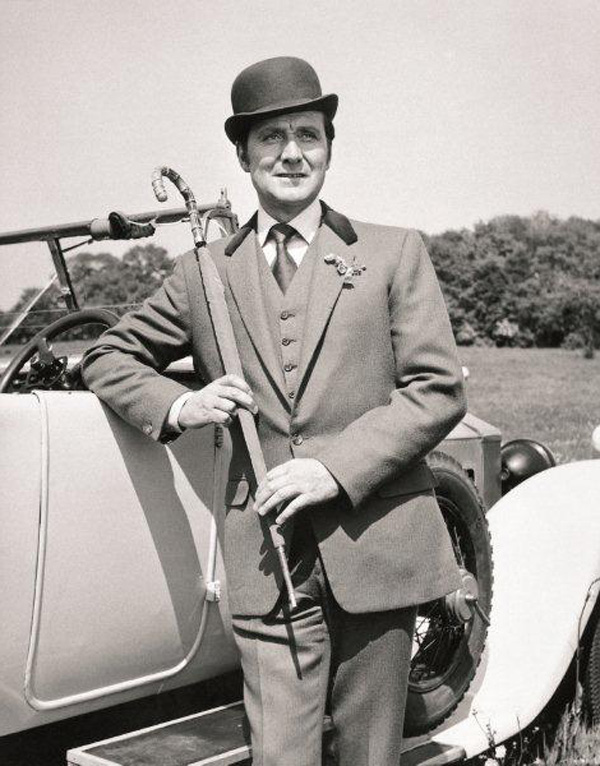
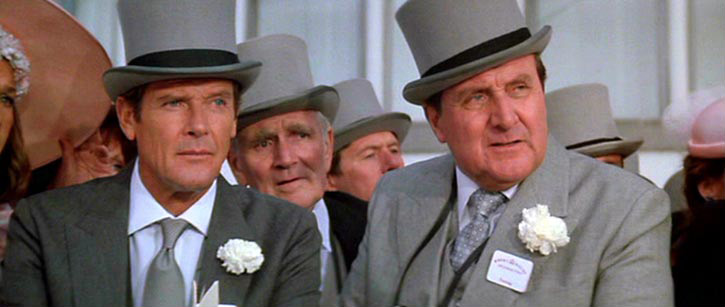
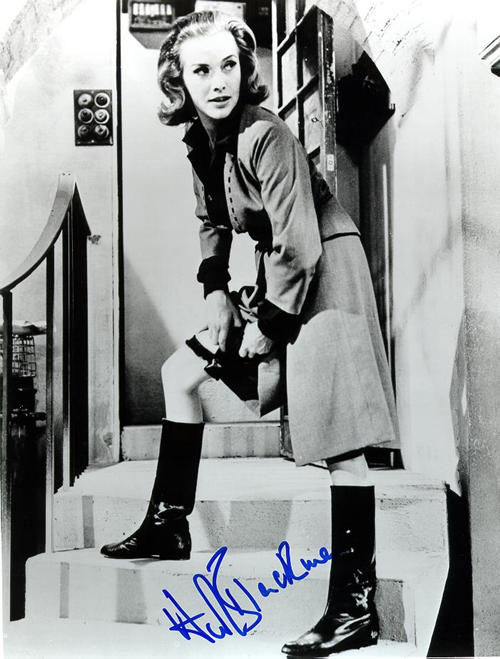
And, we should add some trivia for all fans of such. The aforementioned 'Avengers' of which Honor Blackman was a star, would provide two other actors to later James Bond movies starring two other actors playing the title role of James Bond. Diana Rigg, Mrs. Emma Peel on the Avengers, would play Tracy, the love interest and murdered bride in "on Her Majesty's Secret Service' opposite George Lazenby, the second Bond of the movie series. Patrick Macnee, John Steed of the Avengers, played a role opposite Roger Moore in Moore's last go around as Bond in 'A View To a Kill'. This writer is unaware of any other weekly TV show that contributed three or more of its ongoing actors to the Bond series. Above is a montage of these three actors in their Avenger's personae and their roles in the James Bond movies. Obviously, there is a difference in being in films versus starring in the little screen as two of the Bond parts, Rigg as Tracy Bond and Macnee as Godfrey Tibbett, result in the actor's role's death. Honor Blackman, as Pussy Galore, had a softer landing (if you'll excuse the pun) into the arms of Sean Connery at the end of Goldfinger.
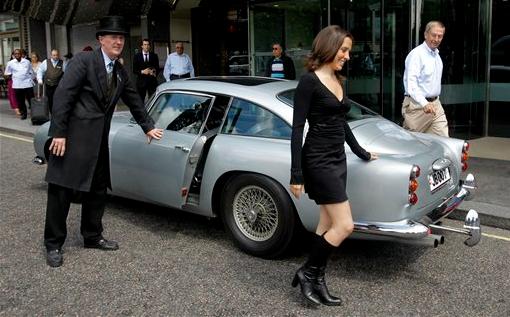

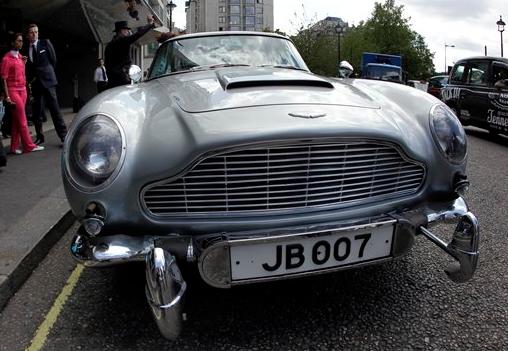
And, we wouldn't want to forget another star of the movie, one which has most kept its shape and performance. We talk about the Aston Martin DB5 displayed above which would be used again in Thunderball. Successive James Bond movies have used a series of cars but none have had the staying power, if not the priciness, of the one above. Besides this author's own private stash of Bond memorabilia, we've used several databases and web sites for this script including the New York Times database. These pictures come from the AP database and were taken on July 21st, 2010 when this car went up for auction. For a measly $4.6 million it could have been yours. Like all props, several of these were created by Aston Martin for the movie including a few that were opened as props for inside shots. This model which we see here is all performance and you can see to the right the machine guns popping out of a turning lights and the reinforced bumpers. Keep in mind that the machine guns are non shooting replicas built into the car and special effects were used to demonstrate their effect just in case you ever are in the position of driving this vehicle and have the need of the added armament. We think that the manufacturer priced this model at 10000 pounds (55000 dollars) at the time of the manufacturing and this price included the added armament and defensive gadgets. You can see that it has appreciated in price over the years. Note: The woman modelling the car is not included in the price.
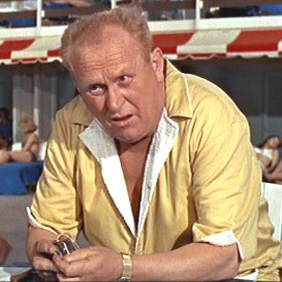
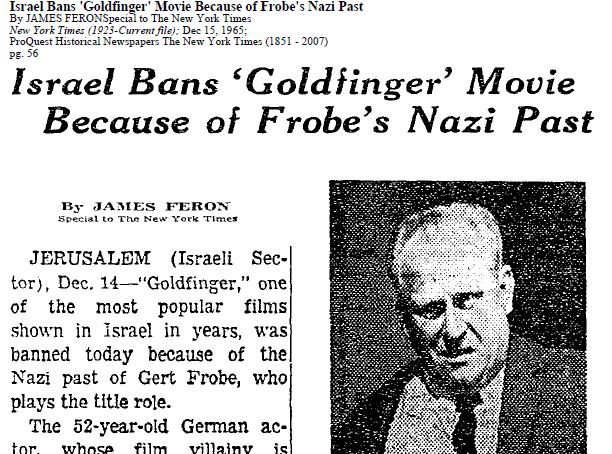
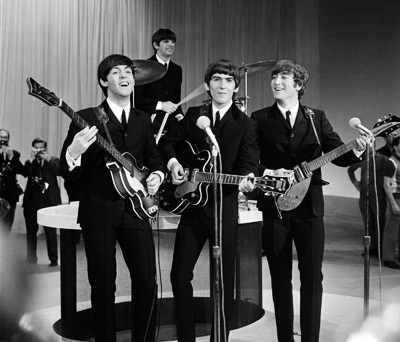
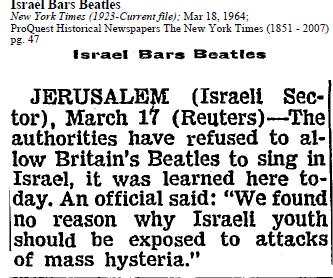
We did promise the editors of this website that we would try to integrate the terms 'Israeli' and 'dancing' into this script given that this is supposed to be a very limited, low level, minor, irrelevant Israeli Dance website. Hopefully we haven't overhyped what the editors of this web site have accomplished in so long a time. Best we can do for them is combine 'Israeli' and 'Music'. This script discusses the two British invasions into this country, the Beatles and Bond, and no country was immune to these effects. In 1964 or so, the Beatles were scheduled to perform in Israel but this appearance was cancelled based on the theory that their music would corrupt the moral values of Israeli youth. A similar situation occurred with the movie Goldfinger. Do you remember that Gert Frobe's voice was dubbed as he spoke no English. He was a German soldier during World War II and in a interview was misquoted to the effect that one could assume that part of Frobe's duties during the war was hunting down Jews. Israel had, and still has, a strict embargo on showing any arts associated with those who have pursued such activities and the movie Goldfinger was banned for a time from that country. So, in early 1965, Israel joined a very select group of countries that had banned both British exports including the Soviet bloc and much of the Arab bloc. The Goldfinger embargo was resolved when an accurate translation of the interview was finally made available and in Frobe's defense, at least two Jewish survivors of the war made statements that Frobe was responsible for hiding them to the war's end. As far as the Beatles are concerned, a great liberalization of media followed and, today, Israel probably is the most open society in the world per the arts and music. All Israeli dancers benefit from this as we are dancing to the best beat and music of the world imported from everywhere for us to enjoy.
We conclude this script reminding you that Bondamania was like every fad: it would have a time limit. Thunderball, the next movie in the series which opened a year later in the United States, did well at the box office but did not seem to have anywhere near the effect of its predecessor(s). Some of this was overkill and media fatique and some of it was discension within the ranks including by Sean Connery who had become tired of the role of James Bond and showed it. So, this script celebrates the two days that we think are the high point of the James Bond 007 influence: Dec 21, 1964 when the movie, Goldfinger, opens and, two days later, on Dec 23rd, 1964 when the movie is the first to go 24/7 in this country. And, we also would be remiss not to remind you that to Mary Fanning Wickham Bond, wife of the ornithologist, James Bond, every day would be a highpoint per her own James Bond's influence.
While we know that there is problems with the following script (and have requested several fixes) you can see a fake powerpoint like presentation of the relationship of Fleming and James Bond the ornithologist to the island of Jamaica by clicking here.
This script is now accompanied by another script dealing with Bondmania from the period of Fleming's death through the publication of the paperback version of 'You Only Live Twice' in 1965. This accompanying script can be found by clicking here.
It looks like our consultant is busy again. There apparently is a script on Bond music that has been added to this web site
As of Aug'16, a new script has been added dealing with August 12th and how it affected Ian Fleming and James Bond.
 Let's start this script by asking you hypothetically what movie you would see next Dec 21st (or perhaps last Dec 21st). Possibly something starring Daniel Craig who seems to appear in many movies (or when this was written in 2011 specifically 'the Girl with the Dragon Tattoo' which starred Daniel Craig at the time). You may recall that Craig has been a star in another series of movies which might give you a hint if we were to ask a similar question: What movie would you go see on Dec 21st, 1964?
Let's start this script by asking you hypothetically what movie you would see next Dec 21st (or perhaps last Dec 21st). Possibly something starring Daniel Craig who seems to appear in many movies (or when this was written in 2011 specifically 'the Girl with the Dragon Tattoo' which starred Daniel Craig at the time). You may recall that Craig has been a star in another series of movies which might give you a hint if we were to ask a similar question: What movie would you go see on Dec 21st, 1964?

















































































































